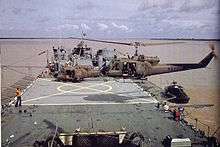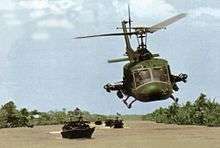HA(L)-3
| Helicopter Attack Squadron (Light) 3 | |
|---|---|
|
HA(L)-3 squadron patch | |
| Active | 1 April 1967 - 16 March 1972 |
| Country | United States |
| Branch | United States Navy |
| Nickname(s) | Seawolves |
| Engagements | Vietnam War |
HA(L)-3, (Helicopter Attack Squadron (Light) 3), nicknamed the “Seawolves”, was an all-volunteer US Navy squadron formed in support of Naval Special Warfare operations and Mobile Riverine Forces during the Vietnam War.
Beginnings of the Navy helicopter gunship
Prior to the Vietnam War, the helicopter was a valued tool within the United States Army for reconnaissance, Search and Rescue (SAR), and medical evacuation of wounded (MEDEVAC).[1] Helicopters within the United States Navy were used for Search and Rescue (SAR), Vertical replenishment (VERTREP), Marine amphibious envelopment, and, experimentally, as mine sweepers. As an offensive weapon, the Navy developed the helicopter as an anti-submarine warfare aircraft, developing the capability to carry and launch torpedoes.[2] As an offensive weapon for ground-based targets, the helicopter was relatively ignored in favor of traditional, fixed-wing aircraft.

In 1965, the US Navy began joint operations off the southern coast of South Vietnam in support of the growing war. In the same year, the Navy began limited river operations in the Mekong Delta, disrupting the Viet Cong's lines of communications, locating supply caches, and eliminating tax collecting stations. Based on the “Brown-water” Navy’s early success, a commitment was made to continue river operations on a full-scale basis in the Mekong Delta. It was also determined that key to the survival of the boats operating in the rivers would be close air support.[3]
Initially, the Brown-water Navy was supported by elements of the 145th Army Combat Aviation Battalion who had greater experience in helicopter gunship operations and tactics. Operating off a “Mothership”, the USS Belle Grove (LSD-2), the Army and Navy worked together on Operation Jackstay. Although the joint effort was a success, it was felt that Naval Aviators and Aircrewman would be more suitable for the mission, especially since the mission would require the pilots and crews to operate off the deck of ships in all weather conditions, day and night. This, coupled with Army’s pilots and aircrews lack of training in shipboard operations, identified a need for a dedicated, United States Navy, helicopter gunship program in Vietnam.[4]
The Birth of the HA(L)-3 and the Seawolves
In 1966, rotary wing support was originated as part of the response to the ongoing war in South Vietnam.[5] Starting with Helicopter Combat Support Squadron ONE (HC-1), detachments of helicopter gunships transfured to the Navy to conduct combat operations in the Mekong Delta region of South Vietnam. HC-1, the “Fleet Angels”, operated two-aircraft detachments of Army UH-1B gunships, staged from shore bases and patrol craft tenders. Providing a quick reaction, close air-support (CAS) role for units of the Navy's Special Warfare Groups and Navy River Patrol Force (also known as the Brown-water Navy), the effectiveness of the helicopter attack mission was quickly realized.
In response, the Navy began to widen the mission requirements.[6] This created a need for a specific Squadron in support of the mission requirements. In April 1967, HC-1 was divided into four separate units, Helicopter Combat Support Squadron THREE (Navy Vertical Replenishment), and Helicopter Combat Support Squadron FIVE (LAMPS, or Light Airborne Multi-Purpose System), and Helicopter Combat Support Squadron SEVEN (Navy Combat Search and Rescue), and Helicopter Attack Squadron (Light) 3 (HAL-(3)), nicknamed the Seawolves.[7]
In 1966, the Navy sent a message fleet-wide, asking for volunteer Naval Aviators to man HA(L)-3. From the response, eighty Aviators were chosen to be the first "Seawolves" and transferred to Vietnam. On 1 April 1967, HA(L)-3 was officially commissioned in South Vietnam under the command of LCDR Joseph B. Howard.[8]
Fighting in Vietnam

The Seawolves would see their first major action while still part of a detachment of HC-1. On 31 October 1966, two Navy boats encountered a superior force of over 80 boats transferring a Viet Cong battalion. Encountering fierce resistance from them, the Navy boat commanders requested close air support (CAS). Scrambling and arriving within approximately fifteen minutes, the Seawolves would claim 16 Viet Cong boats sunk or destroyed.[9]
After the commissioning of HA(L)-3, the Seawolves continued to support Navy Operations. Missions included Search and Destroy patrols, reconnaissance, medical evacuation (MEDEVAC), and SEAL Team insertion and extraction. By the time of their decommissioning on 16 March 1972,[10] the Seawolves flew over 120,000 combat sorties over Vietnam and Cambodia. Over 200 Seawolves would be wounded in combat and 44 would be killed in action.[11]
Post Vietnam War developments
It would take the Navy four years from the decommissioning of HA(L)-3 to realize that it still had a need for this type of specialized, special warfare aviation support. With the establishment of Helicopter Attack Squadron (Light) Four and Helicopter Attack Squadron (Light) Five in 1976 and 1977, the Navy Gunships would once again join the fleet, though be in the United States Navy Reserve. Although these two units would never see combat, their descendents, HCS-4, HCS-5, and HSC-84 would go on to see combat in Operation Desert Shield/Storm, Operation Uphold Democracy, Operation Joint Endeavor, Operation Enduring Freedom. and Operation Iraqi Freedom Freedom.
See also
| Wikimedia Commons has media related to Helicopter Attack Squadron (Light) 3 (United States Navy). |
References
- ↑ HELIS.com, Helicopter History Website, “Gunship Helicopters”, http://www.helis.com/types/gunship.php
- ↑ United States Naval Aviation 1910 – 1995, Roy A. Grossnick, Naval Historical Center, Department of the Navy. Washington, D.C.
- ↑ Navy Seawolves – Early History, HA(L)-3 Official Website, http://www.seawolf.org/history/hal3_history.asp
- ↑ Navy Seawolves – Early History, HA(L)-3 Official Website, http://www.seawolf.org/history/hal3_history.asp
- ↑ http://www.globalsecurity.org/military/agency/navy/hc-1.htm
- ↑ http://bluehawksofhal-5.org/
- ↑ http://www.globalsecurity.org/military/agency/navy/hc-1.htm
- ↑ Navy Seawolves – Early History, HA(L)-3 Official Website, http://www.seawolf.org/history/hal3_history.asp
- ↑ Helicopter Attack Squadron (Light) Three – The Seawolves – Past…Present…Future?, U.S. Classified Memo, 1 December 1971, declassified 25 October 1972
- ↑ US NAVAL FORCES VIETNAM (NAVFORV) Quarterly History Summary for January - March 1972
- ↑ History of the Vietnam Air War Website – HAL(3), http://airwarvietnam.com/hal3.htm
